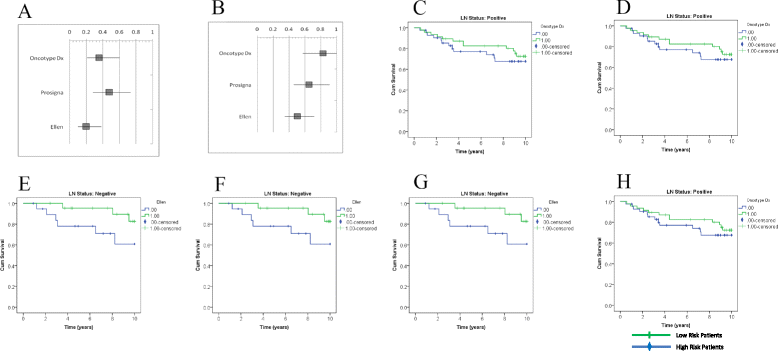The effects of lymph node status on predicting outcome in ER+ /HER2- tamoxifen treated breast cancer patients using gene signatures
- PMID: 27469239
- PMCID: PMC4964078
- DOI: 10.1186/s12885-016-2501-0
The effects of lymph node status on predicting outcome in ER+ /HER2- tamoxifen treated breast cancer patients using gene signatures
Abstract
Background: Lymph node (LN) status is the most important prognostic variable used to guide ER positive (+) breast cancer treatment. While a positive nodal status is traditionally associated with a poor prognosis, a subset of these patients respond well to treatment and achieve long-term survival. Several gene signatures have been established as a means of predicting outcome of breast cancer patients, but the development and indication for use of these assays varies. Here we compare the capacity of two approved gene signatures and a third novel signature to predict outcome in distinct LN negative (-) and LN+ populations. We also examine biological differences between tumours associated with LN- and LN+ disease.
Methods: Gene expression data from publically available data sets was used to compare the ability of Oncotype DX and Prosigna to predict Distant Metastasis Free Survival (DMFS) using an in silico platform. A novel gene signature (Ellen) was developed by including patients with both LN- and LN+ disease and using Prediction Analysis of Microarrays (PAM) software. Gene Set Enrichment Analysis (GSEA) was used to determine biological pathways associated with patient outcome in both LN- and LN+ tumors.
Results: The Oncotype DX gene signature, which only used LN- patients during development, significantly predicted outcome in LN- patients, but not LN+ patients. The Prosigna gene signature, which included both LN- and LN+ patients during development, predicted outcome in both LN- and LN+ patient groups. Ellen was also able to predict outcome in both LN- and LN+ patient groups. GSEA suggested that epigenetic modification may be related to poor outcome in LN- disease, whereas immune response may be related to good outcome in LN+ disease.
Conclusions: We demonstrate the importance of incorporating lymph node status during the development of prognostic gene signatures. Ellen may be a useful tool to predict outcome of patients regardless of lymph node status, or for those with unknown lymph node status. Finally we present candidate biological processes, unique to LN- and LN+ disease, that may indicate risk of relapse.
Keywords: Breast cancer; Estrogen receptor; Gene signature; Lymph node status; Oncotype DX; Prognosis; Prosigna.
Figures


Similar articles
-
Comparison of the Performance of 6 Prognostic Signatures for Estrogen Receptor-Positive Breast Cancer: A Secondary Analysis of a Randomized Clinical Trial.JAMA Oncol. 2018 Apr 1;4(4):545-553. doi: 10.1001/jamaoncol.2017.5524. JAMA Oncol. 2018. PMID: 29450494 Free PMC article. Clinical Trial.
-
Cross comparison and prognostic assessment of breast cancer multigene signatures in a large population-based contemporary clinical series.Sci Rep. 2019 Aug 21;9(1):12184. doi: 10.1038/s41598-019-48570-x. Sci Rep. 2019. PMID: 31434940 Free PMC article.
-
Novel 18-gene signature for predicting relapse in ER-positive, HER2-negative breast cancer.Breast Cancer Res. 2018 Sep 4;20(1):103. doi: 10.1186/s13058-018-1040-9. Breast Cancer Res. 2018. PMID: 30180877 Free PMC article.
-
Avoiding over- and undertreatment in patients with resected node-positive breast cancer with the use of gene expression signatures: are we there yet?Ann Oncol. 2019 Jul 1;30(7):1044-1050. doi: 10.1093/annonc/mdz126. Ann Oncol. 2019. PMID: 31131397 Free PMC article. Review.
-
Multigene expression signatures in early hormone receptor positive HER 2 negative breast cancer.Radiol Oncol. 2019 Sep 24;53(3):285-292. doi: 10.2478/raon-2019-0038. Radiol Oncol. 2019. PMID: 31553709 Free PMC article. Review.
Cited by
-
Multiplex imaging of breast cancer lymph node metastases identifies prognostic single-cell populations independent of clinical classifiers.Cell Rep Med. 2023 Mar 21;4(3):100977. doi: 10.1016/j.xcrm.2023.100977. Epub 2023 Mar 14. Cell Rep Med. 2023. PMID: 36921599 Free PMC article.
-
Impact of the 21-gene recurrence score assay on chemotherapy decision making and outcomes for breast cancer patients with four or more positive lymph nodes.Ann Transl Med. 2019 Sep;7(18):446. doi: 10.21037/atm.2019.08.82. Ann Transl Med. 2019. PMID: 31700882 Free PMC article.
-
Three-year Survival of Women with Breast Cancer in Basrah, Iraq.Oman Med J. 2020 Jul 14;35(4):e147. doi: 10.5001/omj.2020.66. eCollection 2020 Jul. Oman Med J. 2020. PMID: 32728483 Free PMC article.
-
Decision of Adjuvant Systemic Treatment in HR+ HER2- Early Invasive Breast Cancer: Which Biomarkers Could Help?Cancer Manag Res. 2019 Dec 11;11:10353-10373. doi: 10.2147/CMAR.S221676. eCollection 2019. Cancer Manag Res. 2019. PMID: 31849525 Free PMC article. Review.
-
Identification of a Combined RNA Prognostic Signature in Adenocarcinoma of the Lung.Med Sci Monit. 2019 May 27;25:3941-3956. doi: 10.12659/MSM.913727. Med Sci Monit. 2019. PMID: 31132294 Free PMC article.
References
-
- CCO. Surgical Management of Early-Stage Invasive Breast Cancer Overview Guideline Report History. 2011.
-
- NCCN . Practice Guidelines in Oncology. 2012.
-
- Fisher B, Dignam J, Wolmark N, DeCillis A, Emir B, Wickerham DL, Bryant J, Dimitrov NV, Abramson N, Atkins JN, Shibata H, Deschenes L, Margolese RG. Tamoxifen and chemotherapy for lymph node-negative, estrogen receptor-positive breast cancer. J Natl Cancer Inst. 1997;89:1673–1682. doi: 10.1093/jnci/89.22.1673. - DOI - PubMed
-
- Capulli M, Angelucci A, Driouch K, Garcia T, Clement-Lacroix P, Martella F, Ventura L, Bologna M, Flamini S, Moreschini O, Lidereau R, Ricevuto E, Muraca M, Teti A, Rucci N. Increased expression of a set of genes enriched in oxygen binding function discloses a predisposition of breast cancer bone metastases to generate metastasis spread in multiple organs. J Bone Miner Res. 2012;27:2387–2398. doi: 10.1002/jbmr.1686. - DOI - PubMed
Publication types
MeSH terms
Substances
LinkOut - more resources
Full Text Sources
Other Literature Sources
Medical
Research Materials
Miscellaneous

